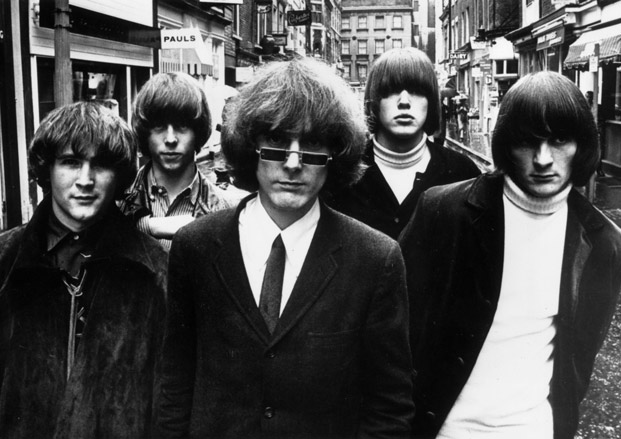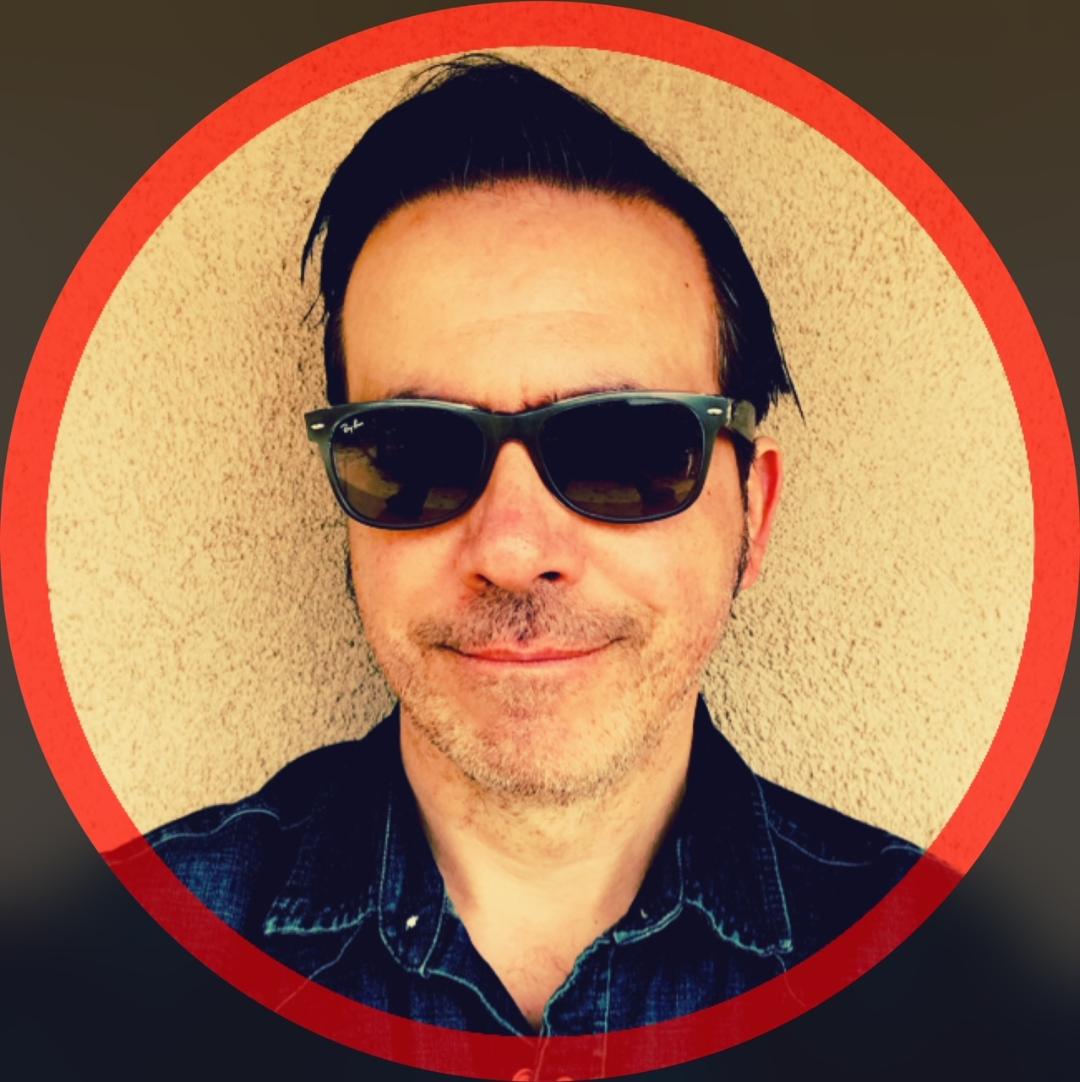The Byrds' 10 Greatest Guitar Moments

From 1965 until their breakup in 1973, the Byrds were a bona-fide electric-guitar powerhouse. During the Southern California band's initial—and most popular—incarnation, Jim McGuinn turned the 12-string Rickenbacker 360 guitar into an institution.
Its glorious trademark "chiming" sound actually became the band's trademark sound—a sound that even influenced the almighty Beatles (who had initially inspired McGuinn to pick up a 12-string Rickenbacker in the first place).
As the years went by and the hits piled up—"Turn! Turn! Turn!," "Eight Miles High," "My Back Pages" and "Chestnut Mare" among them—the band's original lineup—Jim McGuinn,David Crosby,Gene Clark,Chris Hillman and Michael Clarke—went their separate ways, leaving McGuinn to carry on the Byrds experience with a host of new musicians.
Luckily, a guitar legend was waiting in the wings: Clarence White. A master of chops-busting bluegrass guitar, White, who initially recorded with the band as a session guitarist but became a full band member in mid-1968, intertwined his formidable fingerpicking, flatpicking and hybrid-picking technique on his Tele with the use of a device he helped invent (with Gene Parsons), the Parsons-White StringBender (also known as a B-bender), which allowed him to recreate certain aspects of pedal steel guitar licks with stunning accuracy.
It also should be noted that three members of the Byrds—White, McGuinn and Hillman—have (or have had) their own signature-model guitars or basses (Hillman has two—the Martin Guitars OM Chris Hillman Custom Artist Edition and the Guild Chris Hillman Signature Byrds Bass; McGuinn's signature Rickenbacker has been discontinued, but don't forget his signature Martin seven-string model). This, I assure you, is uncommon.
If you'd like to find out more about White, who was killed by a drunk driver in 1973, be sure to check out Ode to the Original B-Bender, Clarence White of The Byrds and Kentucky Colonels.
Below, we revisit 10 of the band's greatest guitar moments, taking their entire official output—including recently released archival live albums—into consideration. The songs are presented in no particular order.
Get The Pick Newsletter
All the latest guitar news, interviews, lessons, reviews, deals and more, direct to your inbox!
For more about the Byrds, visit their official website. To catch up with McGuinn, Crosby and Hillman, visit mcguinn.com,davidcrosby.com and chrishillman.com.
Editor's Note: Even though Roger McGuinn went by his birth name, Jim McGuinn, prior to 1967, we will refer to him as Roger for the remainder of this story.
"Chestnut Mare"
(Untitled) | 1970 | Main Guitarists: Roger McGuinn, Clarence White
Although it's not the first track that comes to mind when considering a list of the Byrds' finest guitar tracks, "Chestnut Mare," an epic song about one tenacious man's quest to capture a very special horse (so special that "she'll be just like a wife"), is actually a perfect choice. It combines McGuinn's trademark electric 12-string picking with White's top-notch acoustic work—with a bit of White's electric B-bender Tele thrown in for good measure.
The guitars, which—let's face it—are everywhere on this track, are the canvas on which the song's story is so vibrantly painted; perhaps the guitar high point is the fine interplay between McGuinn's Rickenbacker and White's Martin during the song's emotional breakdown section.
"Turn! Turn! Turn! (To Everything There Is a Season)"
Turn! Turn! Turn! | 1965 | Main Guitarist: Roger McGuinnNo other song—including "Mr. Tambourine Man" (which did not make this list)—sums up the Byrds' early, "America's Answer to the Beatles" period quite like "Turn! Turn! Turn! (To Everything There Is a Season)." McGuinn's playing on the track is—for lack of a better word—sublime.
Note that he's hybrid picking, playing the melody with downstrokes while providing his own rhythm part in the form of ringing or droning notes and banjo rolls. As always, his 12-string Rickenbacker is front and center. Since you've probably heard the original Byrds version of this song 43,747 times, we've decided to include a more recent video that shows McGuinn playing the song alone, complete with close-up shots of his fingering, finger picks and all. It's from an instructional video McGuinn made several years ago. Enjoy!
"Buckaroo"
Live at the Fillmore—February 1969 | 2000 | Main Guitarist: Clarence WhiteFeel free to argue, but if you had to choose one Byrds album that best demonstrates White's electric-guitar prowess, it'd be Live at the Fillmore—February 1969. The musicians on the album are McGuinn on his 12-string Rickenbacker 360, Gene Parsons on drums, John York on bass and White on his B-Bender Tele. He never puts it down, so there's no escaping it.
The most impressive guitar track on the album is the band's cover of Buck Owens' killer-catchy instrumental, "Buckaroo," which finally exists on YouTube. White rips open his bag of B-bender licks—and never closes it. Even his mistakes sound good, like the random open G string he hits at :32.
"The Bells of Rhymney"
Mr. Tambourine Man | 1965 | Main Guitarist: Roger McGuinn
Although the Beatles were rock’s foremost trendsetters, they still were influenced by other artists. Case in point: George Harrison’s 12-string riff on “If I Needed Someone.” Played in a second-position D-chord shape with a capo on the seventh fret, the line was based on McGuinn’s shimmering guitar work in the mesmerizing 1965 track “The Bells of Rhymney,” which you can hear below.
All McGuinn really had to go on was Pete Seeger's acoustic version of the song, which was based on a poem by Welshman Idris Davies. While Seeger also played the song on a 12-string, and even embellished the solo portion with a brilliant, out-of-nowhere chord or two, McGuinn and the Byrds simply took it to new heights—something they did often, especially when it came to Bob Dylan songs.
In the mid-Sixties, Harrison and McGuinn had formed a mutual-admiration society: “If I Needed Someone” featured Harrison’s second Rickenbacker 360/12, a rounded-off 1965 model that resembled McGuinn’s 1964 Rickenbacker 360/12, which McGuinn bought after seeing Harrison’s first Rick in A Hard Day’s Night.
"You Ain't Goin' Nowhere"
Sweetheart of the Rodeo | 1968 | Main Guitarists: Lloyd Green, Clarence White
Yes, we're bending (that's a play on words, folks) the rules and including a pedal steel guitar performance on this list. The studio version of "You Ain't Goin' Nowhere," a cover of a Basement Tapes-era Dylan tune, features a stunning performance by Nashville pedal steel legend Lloyd Green.
His tone is actually a bit confusing because it sounds like a guitar (I thought it was a guitar for years when I was a young'n). Listen to Green's note choices; it's a lesson on guitar solo composition, regardless of what instrument he's playing.
“I was young and open to any new music if the steel fit, and [the Byrds] were gonna let me be a part of it," Green told Vintage Guitar in 2008. "I thought it was the most wonderful thing. The first song was gonna be ‘You Ain’t Goin’ Nowhere,’ the Bob Dylan song. I said, ‘Where do you guys want me to fill?’ And they said, almost in unison, ‘Everywhere!’ I said, ‘Say no more!’ And if you listen to that song, almost from the first note to the end there’s steel guitar. I play too much, in retrospect—certainly not the way I would play it today."
We've also included a live version of the song (second video) featuring White's B-bender spin on Green's original pedal steel guitar part. This 1968 TV appearance puts the emphasis on White, his still-Nudie-sticker-free Telecaster and his Parsons/White StringBender. Random side note: Be sure to check out Green's pedal steel playing on Paul McCartney and Wings' 1974 tune, "Sally G."
"Black Mountain Rag"/"Soldier's Joy"
Live at Royal Albert Hall 1971 | 2008 | Main Guitarist: Clarence White
Meet Clarence White, the bluegrass shredder. Before joining the Byrds, White was blowing minds (including the mind of the great Doc Watson) as a member of the Kentucky Colonels. His brilliant acoustic flatpicking, which incorporated lightning-fast fiddle lines played on a vintage Martin D-28, helped the bluegrass world recognize the guitar as a lead instrument.
Several masters of the genre, including Tony Rice and Norman Blake, even site him as a key influence. After the Colonels, White became a session player in Los Angeles (even playing on several Byrds albums before officially joining the band). Through his time with the Byrds, this high-octane bluegrass medley stood out as a high point of the band's live shows.
Note that the version below is not the recommended Live at Royal Albert Hall 1971 performance (which isn't available on YouTube), but it's pretty much just as good—and it even shows White and the gang in action, which is a rarity.
"Lover of the Bayou"
(Untitled) | 1970 | Main Guitarist: Clarence White
This live selection sums up the best of White's rare "fuzzed out" guitar attacks. Kudos to White—a former bluegrass picker (as we've mentioned 40 times already)—for coming up with creative and unique rock solos in a time when Eric Clapton, Alvin Lee and Jimi Hendrix were competing for the listening public's attention (and money). Honorable mention to McGuinn, who continued to showcase his Rickenbacker 360 in 1970 and beyond, even though its jingly-jangly "season" (1965 to '66) had temporarily passed.
"Eight Miles High"
Fifth Dimension | 1966 | Main Guitarist: Roger McGuinn"Eight Miles High" starts off like a train—a massive, chugging steam locomotive that stops for absolutely no one. Its cargo? McGuinn's relentless jumble of dark and spider-like notes—all furiously played on his 12-string Rick. The song, which strikes modern ears as an early stab at psychedelia, is actually nothing of the sort.
"We started out with the folky thing, mixing Dylan and Pete Seeger with the Beatles, then we dabbled in a bit of jazz fusion with 'Eight Miles High,' which was misconstrued as psychedelic." McGuinn recently told Uncut. "It wasn’t meant to be, but it was branded that way."
"'Eight Miles High' is out there," McGuinn adds. "It’s spatial. I was trying to emulate Coltrane’s saxophone with my Rickenbacker. It’s got a lot of what Coltrane was going for on India, which was to capture the elephants in India with his wails, and there’s that tabla beat. He was trying to incorporate Indian music into jazz, and we were trying to incorporate his attempts to do that into a rock’n’roll song. So there’s a lot of things going on."
"Sing Me Back Home"
Live at the Fillmore—February 1969 | 2000 | Main Guitarist: Clarence White
If you read the "Buckaroo" entry above, you already know about Live at the Fillmore—February 1969, which gets my vote as White's go-to "guitar album" (in terms of his electric-guitar playing). A few years ago, it even made Guitar World's list of the 30 best shred-guitar albums of all time.
Although I don't think of White as a shredder (except for when he played bluegrass), he certainly works his way toward "shred country" on the Fillmore version of this beautiful Merle Haggard tune, which also was a favorite of former Byrd Gram Parsons. It's another B-bender masterpiece that shows off White's bouncy, psychedelic-cowboy style, complete with a brilliant turnaround at 1:24. It's cool to hear the Fillmore crowd show their appreciation after the solo at 1:43, while McGuinn is already singing the song's next verse.
"She Don't Care About Time"
Non-album B-side of "Turn! Turn! Turn!," now included on Turn! Turn! Turn! | 1965 | Main Guitarist: Roger McGuinn
"She Don't Care About Time," one of many brilliant compositions by the Byrds' Gene Clark, is known for its very early incorporation of classical music into popular music (Take that, Yngwie Malmsteen). Notice how McGuinn cleverly inserts a heaping helping of Bach's "Jesu, Joy of Man's Desiring" into his 12-string Rickenbacker guitar solo.
Damian Fanelli is the online managing editor at Guitar World and Guitar Aficionado. His New York-based band, the Blue Meanies, has toured the world and elsewhere. Fanelli, a former member of Brooklyn jump-blues/swing/rockabilly band the Gas House Gorillas and New York City instrumental surf-rock band Mister Neutron, also composes and records film soundtracks. He writes GuitarWorld.com's The Next Bend column, which is dedicated to B-bender guitars and guitarists. His latest liner notes can be found in Sony/Legacy's Stevie Ray Vaughan: The Complete Epic Recordings Collection. Follow him on Facebook,Twitter and/or Instagram. Or not; either way is fine.

Damian is Editor-in-Chief of Guitar World magazine. In past lives, he was GW’s managing editor and online managing editor. He's written liner notes for major-label releases, including Stevie Ray Vaughan's 'The Complete Epic Recordings Collection' (Sony Legacy) and has interviewed everyone from Yngwie Malmsteen to Kevin Bacon (with a few memorable Eric Clapton chats thrown into the mix). Damian, a former member of Brooklyn's The Gas House Gorillas, was the sole guitarist in Mister Neutron, a trio that toured the U.S. and released three albums. He now plays in two NYC-area bands.
“I loved working with David Gilmour… but that was an uneasy collaboration”: Pete Townshend admits he’s not a natural collaborator – even with bandmates and fellow guitar heroes
“This guy kept calling saying, ‘I’ve never been in a band before, but I’m the best guitarist ever.’ When I heard him play it was like a fire from heaven”: The life and times of Killing Joke visionary Geordie Walker – the guitar hero’s guitar hero







![[from left] George Harrison with his Gretsch Country Gentleman, Norman Harris of Norman's Rare Guitars holds a gold-top Les Paul, John Fogerty with his legendary 1969 Rickenbacker](https://cdn.mos.cms.futurecdn.net/TuH3nuhn9etqjdn5sy4ntW.jpg)


